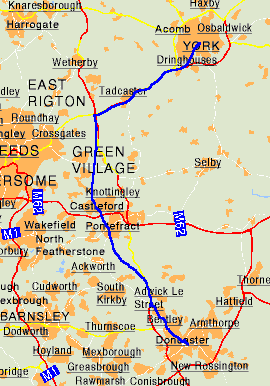| |
| 79 A.D. - Roman Era |
| The name Castleford came from the Romans. Castrum - a camp or fort and
Ford - shallow part of a stream crossed by a road. |
| There is a certain amount of confusion as to what the Romans actually called Castleford. It is variously named Legeolio and Legioleum but the commonly accepted name is Lagentium which translates as "The Place of the Bottles". Taken from the Latin 'lagenae' (bottles or flasks) since evidence of a Roman glass-making industry has been found around Castleford. |
| Castleford was the place where Ermine Street crossed the River Aire. Ermine
Street ran from Danum (Doncaster) down the western boundary of Pontefract
Park, across the end of Smawthorne Lane and Welbeck Street, crossed Carlton
Street at the Junction Inn, passed the Parish Church, down Rectory Street
and across the river near the present dam. Then onwards to Calcaria (Tadcaster)
and Isurium (Aldborough) and the north. A second road from Sheffield and a
third from Chester joined Ermine Street around Pontefract Park thereby making
Castleford a major junction. |
| Agricola was the Roman Governor of Britain and about this date after a great struggle he succeeded in conquering the Brigantes near to Isurium (Aldborough) - his way would lead from Danum (Doncaster) to Lagentium (Castleford), to Eboracum (York) and up to Isurium (Aldborough). |
| A fine example of a Roman Milestone was placed in Beancroft Road in 249 A.D. at the commencement of the reign of the Emperor Decius Trajanus, and is inscribed with his and his son's names and titles. (Both Augustus and his father Decius were killed in battle in 251 A.D.) After his death, it was inverted and reinscribed at the other end with the names and titles of the Emperors Vibius Gallus and his son Vibius Volusianus 251-253 A.D. (I am not sure if this stone was unlucky but both Vibius and son were murdered in 253 A.D. by troops of the usurper Aemilius Aemilianus.) This is now in the Castleford Museum Room. |
| Lagentium was a considerable Roman town at this time as witness the coins, pottery and historical evidence found and was on the main Roman Road North - thus many a Roman Legion must have marched through under such Commanders as Suetonius Paulinus, Agricola, Hadrian, Severus and in particular The Emperor Constantine to be crowned at York. The Romans left around 410 A.D. |
 |
| The Route from Danum to Eboracum via Legioleum. |
 |
| Return To The History Menu |
